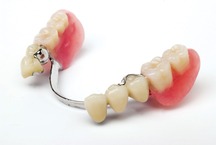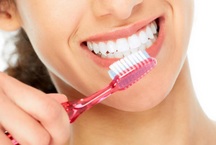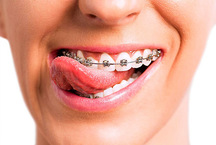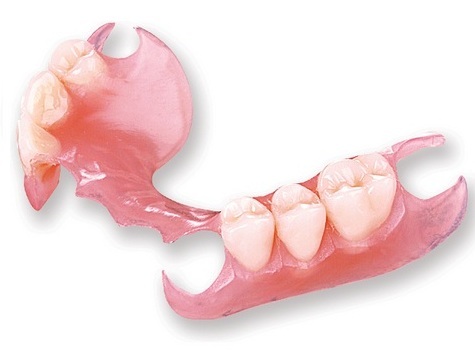
Features of the manufacture and use of nylon prostheses
Previously, nylon prostheses were previously used by doctors only as temporary ones, which allow to correct the defects of the dentition while waiting for the manufacture of a permanent removable or non-removable structure. Due to their positive qualities, they have recently gained popularity as permanent orthopedic structures, and are also used in pediatric practice.
Because of the flexibility and plasticity of the base material, nylon prostheses are called “soft.” They are made of special nylon - modern dentists mainly use Valplast brand polymer, which has high strength and a wide range of colors. The name “silicone prostheses” widespread among the people is absolutely untrue and has gained popularity due to articles written by people who have no specialized education and do not have knowledge in this subject.
The main differences Nylon prosthesis from a similar construction made from a different material are: the absence of metal elements (the prosthesis is fixed using elastic nylon clasps) and the elasticity of the base (the basis of the design), the color of which is selected on the basis of the shade of the patient's gums.
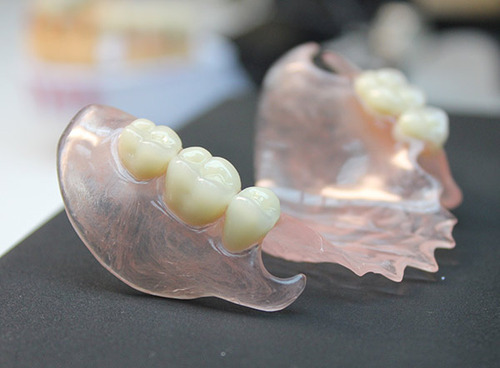
Photo: partial nylon prosthesis
Advantages and disadvantages of nylon designs
Like any orthopedic system, nylon prostheses have their advantages and disadvantages.
The main advantages of nylon prostheses
Orthopedic designs with a base made of nylon, have:
- Hypoallergenic - Nylon does not cause allergic reactions and can be used in patients with allergies to acrylic and metal, as well as in pediatric practice for prostheses that replace early removed milk teeth.
- High aesthetics - Nylon prostheses are called “invisible” because the fixing prosthesis nylon clasps have the color of the patient's gums, they are not noticeable when smiling and talking.
- Reliability and comfort - elastic clasps tightly cover the abutment teeth and securely fix the prosthesis in the patient's mouth, and its low weight and elasticity make it comfortable to use.
- Strength - with proper operation and care of the nylon construction, it is rather difficult to break the denture.
Disadvantages of using nylon designs
Despite the popularity of nylon prostheses, they have a number of drawbacks that need to be paid attention to before making a decision to manufacture just such an orthopedic structure.
The main disadvantages include:
- Accelerated prosthesis subsidence due to atrophy of the bone tissue of the prosthetic bed - elastic nylon clasps cannot transfer part of the load to the abutment teeth as they do (solid in the by-dent denture and made of hard wire in acrylic), therefore, the chewing load is completely distributed on the tissue of the prosthetic bed. In combination with the high flexibility of the prosthesis, due to which pressure is exerted directly on the gum site from the side of the chewing load, this leads to accelerated atrophy of the bone tissue and the need to relocate or completely replace the prosthesis.
- Injury of the gum edge in the area of the abutment teeth - when the prosthesis subsides, the edge of the cloummers injures the mucous membrane of the gums near the supporting teeth, causing the development of the inflammatory process in these places.
- Elastic deformation of the basis of the prosthesis during chewing - due to the increased flexibility of the frame, pressure on the mucous during chewing is transmitted only to the area that is located directly under the part of the prosthesis involved in chewing.
- Low hygiene use - the nylon prosthesis is not polishable inside and is poorly polished outside, so it requires periodic professional cleaning, as the base may become rather cloudy rather quickly, and the prosthesis begins to smell unpleasantly. In order to clean the nylon prosthesis, you must often visit the dentist or purchase a special ultrasonic bath.
- The need for frequent corrections - due to the increased flexibility and elasticity of the prosthesis made to replace a large defect, it can unpredictably deform, which leads to the need for its correction. Throughout its use, you should periodically consult a doctor in order to eliminate the discomfort caused by the deformation of the prosthesis.
- Fairly high cost - the price of a nylon prosthesis is almost 5 times higher than the cost of acrylic and only slightly lower than the price of a byugelny one.
It is worth noting that small prostheses “butterflies”, replacing the absence of 1-2 teeth, do not have the disadvantages of large nylon prostheses and can be an excellent alternative to fixed prosthetics or implantation.
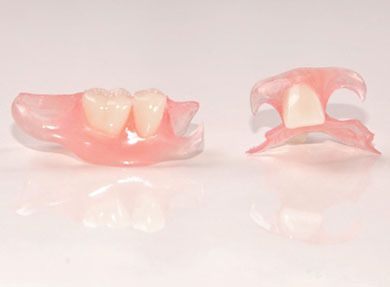
In the photo: nylon prosthesis - "butterfly"
Indications and contraindications to the use of nylon structures
Indications
The use of nylon structures is advisable in the following situations:
- if the patient has an allergic reaction to acrylic or metal;
- with partial edentulous (most suitable nylon designs, replacing 1-2 missing teeth);
- in pediatric practice for replacing early removed milk teeth;
- with stomatitis, the cause of which is the wearing of an acrylic prosthesis;
- if the patient does not want to process the abutment teeth because of the absence of 1-2 teeth in a row.
Contraindications
The manufacture of nylon structures is contraindicated in the following cases:
- with a high degree of bone tissue atrophy, due to the wearing of a nylon prosthesis, it progresses rapidly;
- with a low height of the crowns of the remaining teeth;
- with high compliance of the oral mucosa;
- in the presence of inflammatory periodontal diseases and the associated mobility of the remaining teeth;
- in inflammatory diseases of the oral mucosa - chronic gingivitis (catarrhal, hypertrophic or ulcerative).
Prosthetics with full edentulous and end defects of the dentition
Nylon prostheses with full edentulous (absence of all teeth) are used in extremely rare cases with other indications for their manufacture. With this pathology, it is more advisable to use a conventional acrylic prosthesis, clasp or fixed prosthetics on implants.
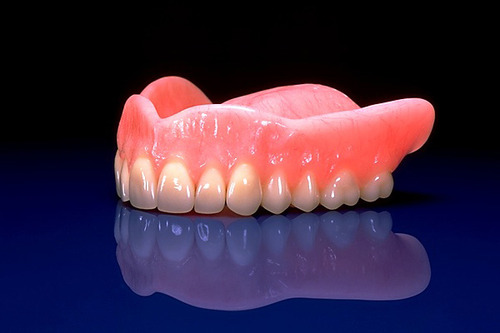
Photo: full nylon prosthesis
If there are no teeth at the end of the row, it is recommended to use a nylon prosthesis on the attachments - the last one in the row of the tooth is covered with a metal-plastic crown in which one part of the locking is placed, the second part is placed on the prosthesis itself. Such a construction will prevent the denture from being thrown off when talking and eating, but will significantly raise its cost. An alternative to the above-described system is a clasp prosthesis, and in the absence of one tooth, a fixed construction with a console.
Features of the operation of nylon prostheses
Duration of operation
The maximum lifetime of a nylon prosthesis is five years, and this is possible only in cases where all indications for the use of this type of prosthesis are observed. To extend the life of the prosthesis, you need proper care and periodic professional cleaning of the prosthesis in the dental office or using an ultrasonic bath at home.Sometimes replacement of the prosthesis is required after 1.5-2 years of use.
Adaptation features
Adaptation to small prostheses made of nylon (the so-called "butterflies") is easy and takes from one to 5 days. The small size and weight, reliable fastening, low load, lack of discomfort and the ability not to remove the prosthesis at night make it comfortable to use.
A long or full length nylon prosthesis requires much more time to get used to. Periodic correction, pain and discomfort when chewing, subsidence of the gums prevent a person from adapting to a removable prosthesis. In some situations, the patient feels discomfort throughout the entire life cycle. Such dentures have more disadvantages than advantages, therefore, with full edentulous or large gaps in the dentition, it is worth thinking about another type of prosthetics.
Types of nylon prostheses, their purpose and cost
The cost of a nylon prosthesis is formed on the basis of the size of the defect, the material used for the manufacture of the prosthesis, the qualifications of the dentist and the technician, so the actual prices may vary slightly. The table shows the average cost of each type of nylon prosthesis.
|
№ |
Type of prosthesis |
Purpose |
Cost of |
|
1. |
Full nylon prosthesis |
It is used with full edentulous in rare cases when the patient is allergic to acrylic and metal, or prosthetic stomatitis. |
From 25,000 |
|
2. |
Partial Nylon Prosthesis |
Used to replace the included (limited on both sides) defects of the dentition. |
From 20 000 |
|
3. |
Butterfly Nylon Micro Prosthesis |
Its manufacture is shown for small defects with a length of 1 to 3 teeth. |
From 15 000 |
|
4. |
Nylon prosthesis with lock fastening |
Suitable for prosthetics with end defects (absence of teeth at the end of a row on one or two sides). |
From 35,000 (the price includes a metal-ceramic crown and attachment) |
Stages of manufacturing nylon prostheses
As with any prosthetics, the clinical and laboratory stages of manufacturing an orthopedic structure can be distinguished. The duration of the laboratory stages depends on the location of the laboratory itself and its equipment. Some clinics have their own dental laboratories, which greatly accelerates the manufacture of the prosthesis.
Stages of prosthetics with nylon structures
- Preparatory - this is the clinical stage at which the doctor carries out all the necessary preparatory measures: the treatment and removal of sick teeth, professional oral hygiene. Its duration depends on the condition of the patient’s oral cavity and may take from several days to 1-2 months.
- Taking impressions is a clinical stage at which a doctor uses impressions to take impressions from the patient’s jaws, for the manufacture of a prosthesis, it may be necessary to take 2 impressions from each jaw. The duration of the stage is from 30 minutes to an hour, it takes one visit.
- The manufacture of wax rollers is a laboratory stage at which in a technical laboratory rollers are made from wax to determine the height of the bite and the shape of the patient's dentition. The stage can take from 1 to 3 days.
- Gnawing on wax rollers - the clinical stage, the duration of which can be 15-30 minutes, will take one visit.
- Making a wax base with artificial teeth installed on it - the laboratory stage at which a technician makes a wax prosthesis takes from 1 to 3 days.
- Trying a wax prosthesis - the clinical stage in which the accuracy of the prosthesis manufacturing and its compliance with the patient's bite is determined, takes from half an hour to an hour (one visit).
- Manufacturing a prosthesis of nylon is made in the laboratory and takes from 1 to 5 days.
- Delivery of the prosthesis to the patient is a clinical stage that takes from 30 minutes to 1.5 hours.
In general, making a nylon prosthesis may take from 3-5 days in the clinic, which has its own technical laboratory, up to two weeks.
Nylon prosthesis care and repair
To extend the life of the nylon prosthesis, you must follow the following rules of care:
- when using a prosthesis it is necessary to ensure that did not fall into heightssince the teeth that have dropped out of the base cannot be replaced, and therefore a new prosthesis will be required;
- is necessary get and wash the denture after every mealin order to avoid unpleasant smell from the prosthesis and clouding of its basis;
- handle denture once a day bactericides intended for this purpose;
- Store it in a special fluid only when it is necessary to remove the prosthesis from the mouth for a long period of time;
- to clean the prosthesis from soft and hard dental deposits 2-3 times a year to visit the dentist or purchase intended for this ultrasonic bath.
Repair Nylon Prosthesis
The need for repair is initially caused by improper construction of the structure, deformation of the base, increased load on the prosthesis and violation of the rules for caring for it.
- In case of damage or loss of artificial teeth or damage to the basis of the prosthesis (cracks), its replacement will be required.
- When a tooth falls out or is removed, it is possible to add it to the base of the prosthesis in the event that the tooth was not supporting.
- In case of incomplete fit of the base, a relocation of the prosthesis will be required.
- With poor fixation will require activation clasps.
Repair of the nylon construction is free of charge if the warranty period has not been reached (in most clinics it is one year), otherwise you will need to pay for repairs.
Patient Reviews on Nylon Prostheses
Galina 23 years old - At the age of 17, I was removed the sixth tooth in the upper jaw, spoiled during my school years. For a long time I complexed and could not smile, constantly remembering the presence of a gap. My dentist suggested not to process the adjacent teeth in order to put in place a metal-ceramic bridge, but to use a nylon “butterfly”. For three years now, I have been using this prosthesis until I noticed any flaws, except that I need to visit the doctor 2 times a year so that he can greet the prosthesis in order.
Mikhail 62 years old - I am not satisfied with the full prosthesis of nylon, because it was loosely fixed and delivered constant unpleasant and even painful sensations while eating. In addition, the gum quickly subsided and had to be replaced after three years.
Maria 48 years - A partial nylon prosthesis was installed two years ago, there were no front teeth and I didn’t want to have a prosthesis with metal fixings that would be visible in a smile. Aesthetics at a height of course, but the fact that you have to contact the dentist from time to time for correction does not like a little.
